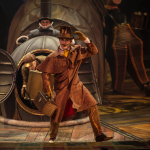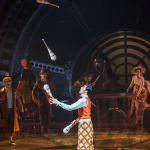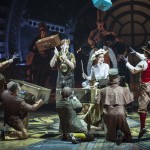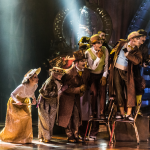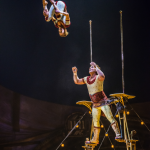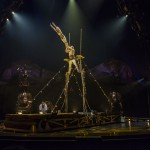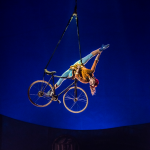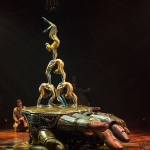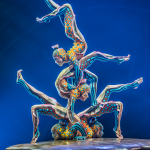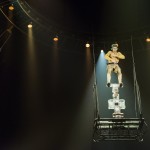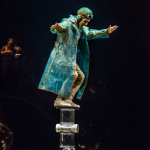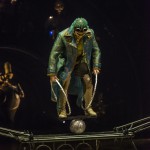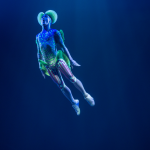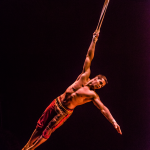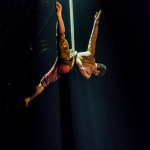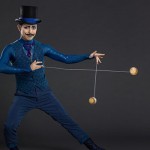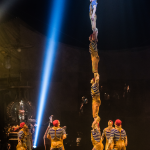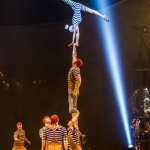Robots & Rola Bola – KURIOS: Cabinet Of Curiosities by Cirque Du Soleil
The latest touring troupe for the French Canadian entertainment company combines a steampunk aesthetic with superhuman acrobatic and aerial routines
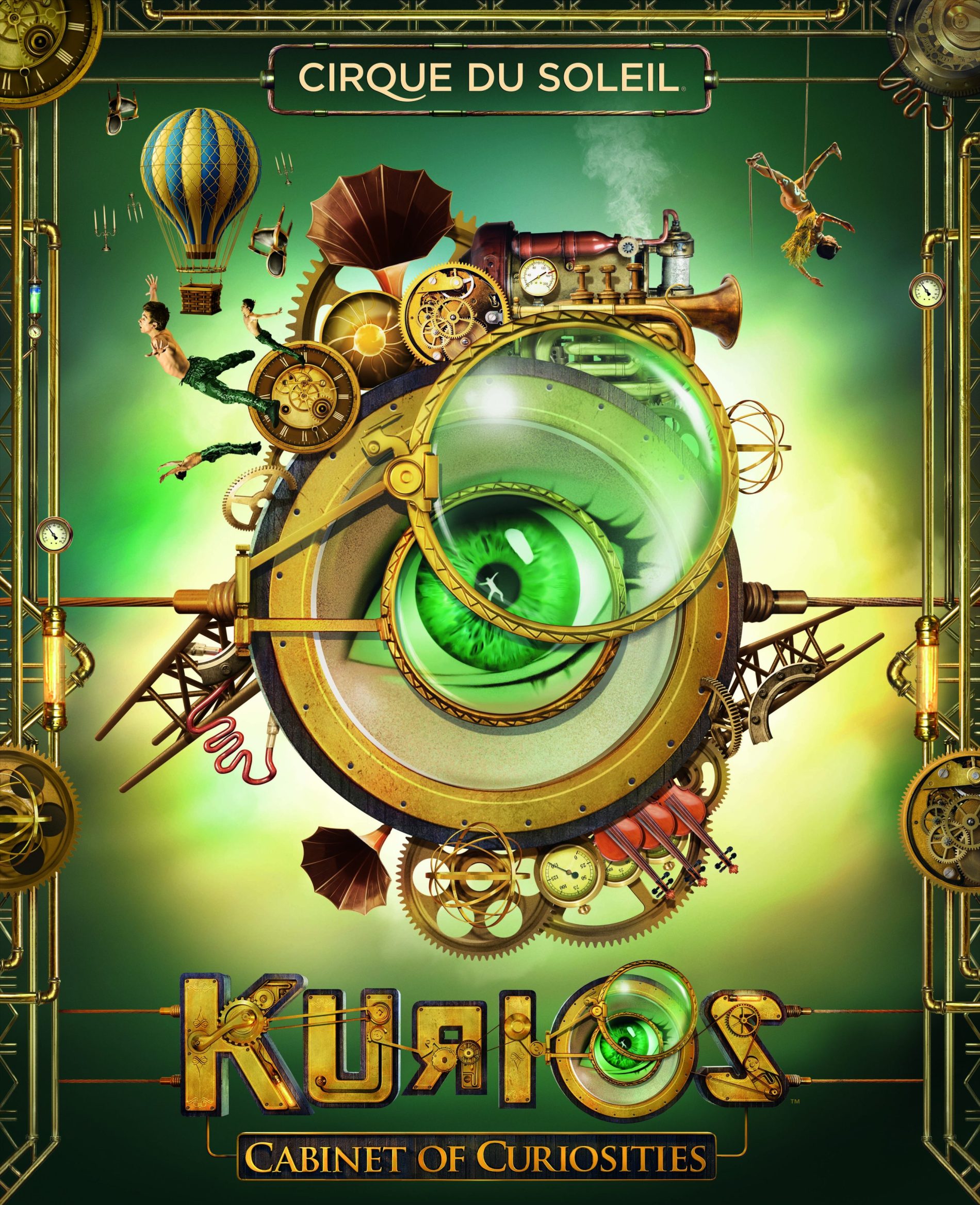
All mages provded courtesy of Cirque Du Soleil
It was less than 10 minutes until showtime when we made our way to our seats — the trademark yellow and blue wavy stripe design decorating our massive pop-corn tub, matching the big top that we were now within the belly of. We were fortunate enough to be seated about 6 rows back, just as we had been on our previous visit 2 years ago — a clear benefit of having been comped reviewer passes — but, due to the circular stage and seating arrangement, there doesn’t seem to be a bad seat in the house.
As we settled in, performers were already beginning to move about the stage and making their way into the crowd to interact with audience members. Among the characters was a man that resembled the fortune telling Professor Marvel, that encourages Dorothy to return home at the beginning of The Wizard Of Oz, but with a giant glass dome containing holographic projections protruding out from the top of his swami turban like a massive brain. Meanwhile, a similar aesthetic to the film’s much darker 1985 quasi-sequel, Return To Oz, is present in everything from the exposed riveting on the retro-futuristic robot servants (aka “The Kurios”) that are relegated to menial tasks like sweeping, to the brass external gramophone horns and illuminated over-sized vacuum/electron tubes that adorn different areas of the stage. The focus quickly turned to a bumbling scientist type (credited as “The Seeker” on the official site), as he and his assistants — previously interacting with the crowd — intently tinker around with a large scale contraption, with little success.
Kurios is the fourth different Cirque Du Soleil show that I’ve seen since the mid-90s and each one of them has some form of clown to address the crowd and provide comic relief during set up and transitional periods. After a quick announcement from this emcee, once the room had darkened, a group of performers made their way through the aisle behind us in a train (literally). Not unlike a dragon costume winding through a Chinese New Year celebration, the upper bodies of the men at the front of the line were equipped with harnesses that supported each of the separate connecting components of a steam train overhead, complete with a beam of light guiding the way. They were trailed by a line of musicians/passengers, providing the soundtrack as they traveled in. With the focus back on The Seeker, the inventor finally got his machine to start up and climbed up into a massive chair, only to climb back down as it was being sucked backwards off the stage. Somehow, this resulted in 3 figures wearing conical masks gradually descending through smoke from the ceiling.
 Nico the Accordion Man‘s top hat and overalls, which are designed to create little separation between the humanoid’s attire and his organic physical structure, accordion (if that’s a verb) like fireplace bellows, while the graduated tiers that combine to form Klara the Telegraph of the Invisible‘s collapsible hoop skirt encircle her body like orbiting rings. The finger-waves in the latter’s flapper-era hairdo, surprisingly do not conflict with her cold, mechanical makeup and the antennae-like accessory erected from the top-center of her head. Her look is an abstract, vaguely exotic one of no specific origin, as her appearance falls somewhere around a mystical East Indian goddess, if filtered through Fritz Lang‘s groundbreaking 1927 German expressionistic Sci-Fi film, Metrolopis, crossed with a Jetsons episode set in a speakeasy. As is to be expected with the Cirque, their costuming is flawless; however, although this pair of characters appear throughout the show, their actual involvement is mostly peripheral in nature, appearing primarily during transitions — I remember very little about their actual “roles.” If there is one figure that is at the center of things — perhaps, even takes on the role of “ringmaster” for this fantastical, animal-free French-Canadian circus — it is the third member in this crew, Mr Microcosmos. A rotund specimen, Microcosmos has an iron torso that resembles a bathysphere, except with the submarine-style opening valve placed in front like an industrial safe, where a porthole would normally be positioned. He opened two flaps on the top of his belly like a trap door and all 3 of them used it like a receptacle to dispose of their facial protection.
Nico the Accordion Man‘s top hat and overalls, which are designed to create little separation between the humanoid’s attire and his organic physical structure, accordion (if that’s a verb) like fireplace bellows, while the graduated tiers that combine to form Klara the Telegraph of the Invisible‘s collapsible hoop skirt encircle her body like orbiting rings. The finger-waves in the latter’s flapper-era hairdo, surprisingly do not conflict with her cold, mechanical makeup and the antennae-like accessory erected from the top-center of her head. Her look is an abstract, vaguely exotic one of no specific origin, as her appearance falls somewhere around a mystical East Indian goddess, if filtered through Fritz Lang‘s groundbreaking 1927 German expressionistic Sci-Fi film, Metrolopis, crossed with a Jetsons episode set in a speakeasy. As is to be expected with the Cirque, their costuming is flawless; however, although this pair of characters appear throughout the show, their actual involvement is mostly peripheral in nature, appearing primarily during transitions — I remember very little about their actual “roles.” If there is one figure that is at the center of things — perhaps, even takes on the role of “ringmaster” for this fantastical, animal-free French-Canadian circus — it is the third member in this crew, Mr Microcosmos. A rotund specimen, Microcosmos has an iron torso that resembles a bathysphere, except with the submarine-style opening valve placed in front like an industrial safe, where a porthole would normally be positioned. He opened two flaps on the top of his belly like a trap door and all 3 of them used it like a receptacle to dispose of their facial protection.
While the aesthetic is unmistakably steampunk — or, more so, because of that very reason — the creators find ways to play with that retro-futuristic concept to exploit the timeline and mash various genres together wherever possible. This allows them to deliver things based more on if the general feel behind them seems cohesive, rather than become overly concerned about specifics pertaining to historical continuity. It’s a lot like how cavemen didn’t exactly exist during the same time as dinosaurs, or, even more accurately, like how the triceratops and stegosaurus were from two completely different ages, some 80-million years apart, but nobody questions it when they’re seen side-by-side in a film like The Land Before Time. Time machines, after all, yield such concerns obsolete, and these folks are setting off some heavy H.G. Wells vibes throughout this show.
This approach further bleeds into the musical score which integrates elements from such genres as old-timey jazz, ragtime and bigband music with klezmer and electro-swing. If the Kurios band were to be placed on a concert bill, they could find a comfortable home performing alongside such contemporary acts as gypsy punks, Gogol Bordello, and the Balkan folk stylings of the band Beirut. The music stood out immediately and I actually preferred it to the more prog-driven soundtrack of Amaluna, the touring Cirque act that we caught previously. I also enjoyed how the band was integrated into the show toward the beginning, yet stayed primarily in the background and off stage throughout the remainder of the show.
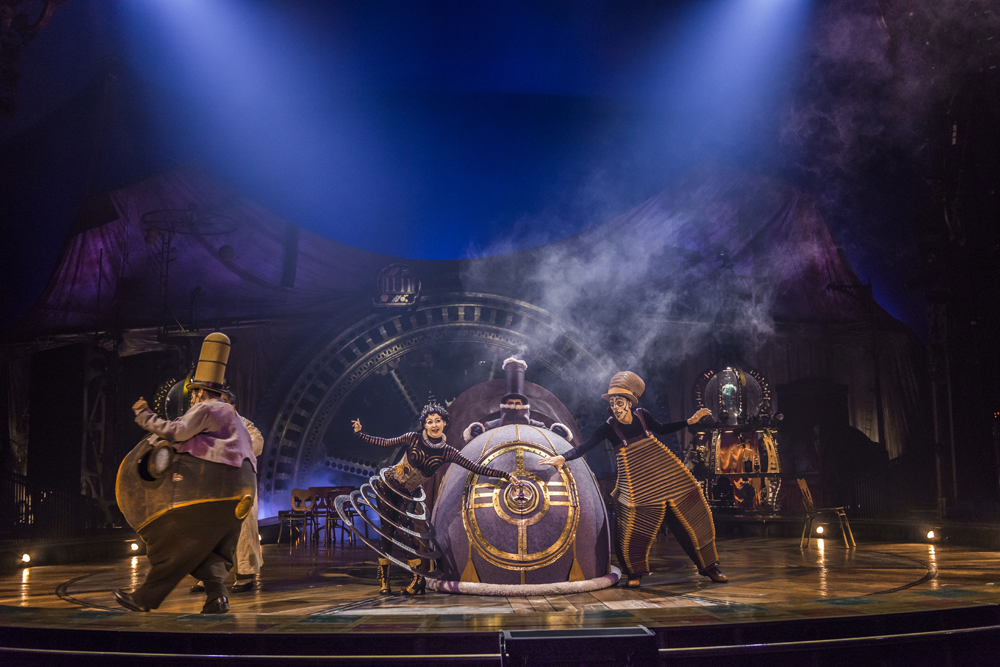
A long train pulled onto the stage. The rounded metal front end, which resembled Microsmos‘s body (and later was used as it), had a man poking out from the top with a top hat like a smokestack. Before scurrying off to the sides and out of the way, Nico and Klara opened the hatch, allowing one character after another to scatter out from the front. An elaborate broadway-caliber sequence ensues, with a dapper gent skillfully juggling a numerous clubs, as a swarm of fellow dandys holding luggage pour out from their railway transport. The conductor is joined by a finely dressed woman as they showcase their impressive drumming abilities — both with hands and sticks — on a table top, as well as various pieces of luggage, in an elaborately orchestrated number involving the rest of the passengers being required to rotate in, toss their luggage around, and hit their marks right on beat for the agile percussionists to strike the various surfaces as they hustle around the stage.
Other notable stunts in the sequence include men shifting chairs from the back of a line up to the front to provide a walkway, of sorts, on the spot for the damsel as she steps across them, and passengers positioning themselves strategically to form the shape of a human face toward the crowd — a pair of bowler hats held over their chests became eyes. Great care was put in to insure that the performers rotate around the stage to allow every audience member to experience the visuals, regardless of where they were positioned among the perimeter. Of course, this creates additional work for the performers who often have to repeat things at different focal points, especially with so much taking place at once, but that’s what makes this group so phenomenal. After the juggler was elevated up high toward the rafters, while continuing to juggle unphased, he flung one club high up into the air and was sent plummeting down, only to catch it again during his decent. That was the first moment of the night that fully defied logic and human limitations, as we previously understood them, and is another prime example of the super human abilities that rigorous and extensive training has afforded these performers. I looked over at my fiance, Kim and she was already crying. It took even less time than it did when we were at this venue 2 years ago. This was only the opening sequence.
The first “real” act was the Russian cradle duo who emerged from a case that is meant to represent a music box. Animated by an electrical charge, they climbed a platform on which the strongman used his brute strength to flip and catch his female partner around. The rotating platform continues to demonstrate their focus on making sure that every vantage point is a solid one. The act itself is impressive enough — it’s a meat and potatoes act, with little flash — but it’s really the introduction, which provides a great transition and, much like The Nutcracker, blurs the lines between reality and fantasy in a way that brings anticipation for what’s to come.
A delivery woman on a bike was lowered down from the ceiling, riding in the air suspended. She twisted around on the frame, rode the bike upside-down, hung from the tires and, just basically, weaved her body all around the thing, freezing in elegant shapes, doing splits, spinning around rapidly, and doing all manners of acrobatic stunts while utilizing the shape of the cycle. As she was lifted back up, she floated a note down on a parachute to Mr Microcosmos. Microcosmos then gabe that letter to a tiny woman that resides inside of his torso, who’s size was comparable to that of my 3-year-old — the official releases refer to her as “Mini Lili.” The bike routine was alright, but again, it was the oddity of a miniature woman that trumped the act itself by transporting us to a place where my eyes actually felt as if they might be deceiving me.
The emcee returned to bring some comic relief in the form of an “invisible circus.” A non-existent diver splashes into a pool. A unicycle with no visible rider rolls across a tight rope. You get it; that sort of thing. I wasn’t particularly entertained with that bit, but it operates as solid filler, assisting in the necessary transition between acts and prime entertainment for any children in attendance. The second half of the show — the evening is split in 2 by an intermission — featured him doing crowd work by bringing a female from the crowd on stage and attempting to woo her in an apartment like setup; a routine that I actually did enjoy. Like I said, the clowns — who, perhaps, actually operate more as “ringmaster” than Microcosmos, to a certain extent– are common for the Cirque and they do the job of breaking things up and adding dimension. They’re not my favorite aspects of these shows, but they do keep the audience engaged and pull them back in when necessary.
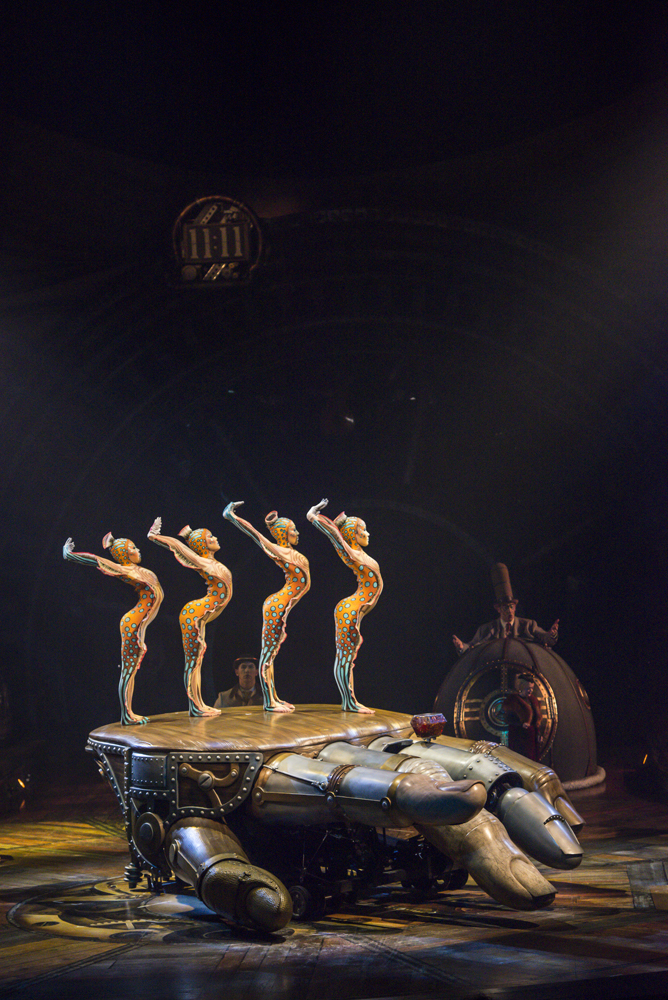 The next act was delivered on the top of an outstretched mechanical hand, which rolled out onto the stage and looked as if it could have been dismembered from the automaton in Hugo. (a film set in the 1930s). Four contortionists, dressed as what appeared to be some sort of sea-life, mangled their bodies into some truly impressive silhouettes and pyramids. According to the official description, they were supposed to “embody electric eels,” which I can understand, based on their flexibility alone, but the colors of their full body suits were vibrant amber and electric blue, as eye-catching as the Steve Zissou‘s jaguar shark. The narrative really began to slip up for me around this point — I wasn’t quite sure how these sea creatures related to the cold mechanical hand that they performed on — but it was still one of my favorite acts of the night. There was a weird balance that the show attempted to tread between the fantastical and the very blue-collar and historic reality of working in the industrial age and it didn’t always work for me, leaning too far toward one direction or the other. With these contortionists, the figures existed solely in that realm of the mythical with the performers truly embodying their costumes and appearing as otherworldly creatures. Every act that I’ve ever seen from Cirque Du Soleil in any of their shows has been impressive, because the performers are the greatest at what they do anywhere; it’s hard to fathom how a human being can pull off such feats. These contortionists, however, cross that line to where the logical mind slips away and the senses take over. Whatever these women were, they ceased to be human and became something much more than that. And when they worked in unison, they even became more than the sum of their parts; splitting like amoebas and reforming as one multi-limbed wriggling organism. Adding to that success is the fact that, although I’ve seen contortionists before and have even seen the skill used brilliantly by the Cirque, themselves, in other shows, this act truly delivered in a way that seemed fresh and in a manner that I felt as if I had never really seen it before. It’s a difficult task to pull off and is a prime example of when costumes, sets, routine, and music are all blending perfectly together with an awareness of how the final product is filtered through the perspective of the observer.
The next act was delivered on the top of an outstretched mechanical hand, which rolled out onto the stage and looked as if it could have been dismembered from the automaton in Hugo. (a film set in the 1930s). Four contortionists, dressed as what appeared to be some sort of sea-life, mangled their bodies into some truly impressive silhouettes and pyramids. According to the official description, they were supposed to “embody electric eels,” which I can understand, based on their flexibility alone, but the colors of their full body suits were vibrant amber and electric blue, as eye-catching as the Steve Zissou‘s jaguar shark. The narrative really began to slip up for me around this point — I wasn’t quite sure how these sea creatures related to the cold mechanical hand that they performed on — but it was still one of my favorite acts of the night. There was a weird balance that the show attempted to tread between the fantastical and the very blue-collar and historic reality of working in the industrial age and it didn’t always work for me, leaning too far toward one direction or the other. With these contortionists, the figures existed solely in that realm of the mythical with the performers truly embodying their costumes and appearing as otherworldly creatures. Every act that I’ve ever seen from Cirque Du Soleil in any of their shows has been impressive, because the performers are the greatest at what they do anywhere; it’s hard to fathom how a human being can pull off such feats. These contortionists, however, cross that line to where the logical mind slips away and the senses take over. Whatever these women were, they ceased to be human and became something much more than that. And when they worked in unison, they even became more than the sum of their parts; splitting like amoebas and reforming as one multi-limbed wriggling organism. Adding to that success is the fact that, although I’ve seen contortionists before and have even seen the skill used brilliantly by the Cirque, themselves, in other shows, this act truly delivered in a way that seemed fresh and in a manner that I felt as if I had never really seen it before. It’s a difficult task to pull off and is a prime example of when costumes, sets, routine, and music are all blending perfectly together with an awareness of how the final product is filtered through the perspective of the observer.
The next act began with a handful of people sitting around a table having a dinner party. One of the men then went on to display telekinetic powers, moving objects with his mind. He then proceeded to have chairs handed up to him, stacking them higher and
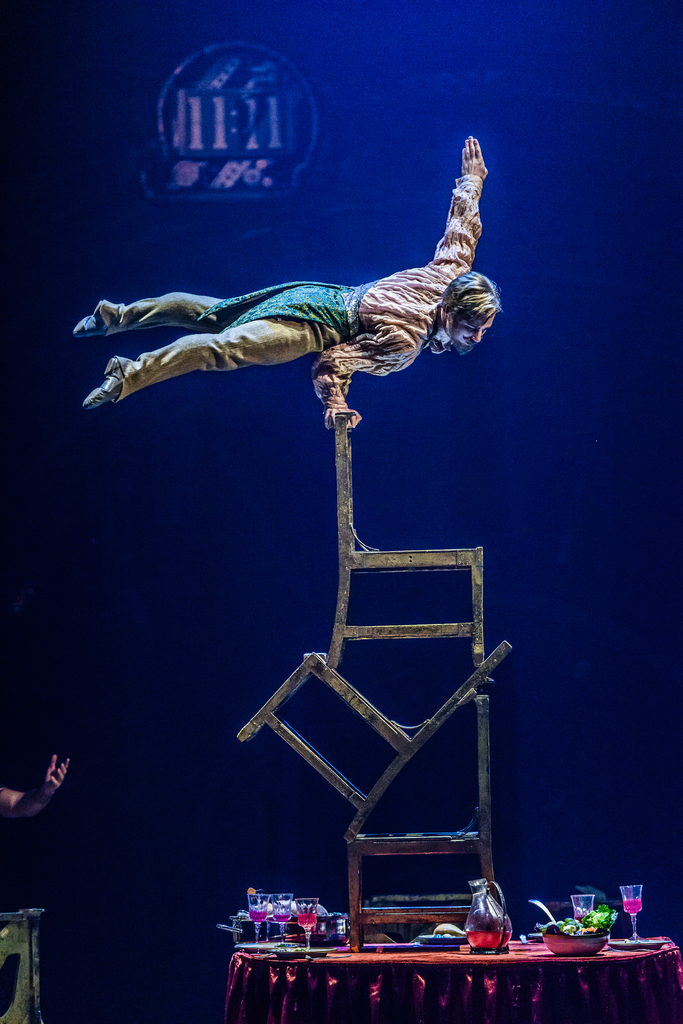 higher in a balancing act. Presumably, he was attempting to reach the chandelier high above them, which he had affected with his powers just prior. This is a classic act that takes incredible skill — balancing chairs in precarious angles and positioning them on top of each other — but it’s also when I discovered how demanding and jaded I have become. I’ve seen similar routines performed before, namely with Chinese circus troupes, and my standards have likely become unfairly high for this company in particular; I expect them to completely blow my mind out of the back of my skull with everything they do, every time. The agile performer was even pulling out some fairly acrobatic moves on top of the chairs that he was stacking, and I was still sufficiently unmoved. Fortunately, right at the point that I noticed how dismissive I’d become, I also noticed the disorienting affect they were pulling off, as another table up in the rafters, directly above the diners below, was upside-down and reflecting an inverted image. What I mean by that is that another table that was upside-down above them, complete with identical dinner guests, was mirroring them as if reflecting an alternate dimension. In fact, another man began to defy gravity by “balancing” similar chairs off of his table and toward the doppleganger that was attempting to reach up toward them. For me, this was a definite standout portion of the evening and the perfect way to add another new spin to a more familiar routine.
higher in a balancing act. Presumably, he was attempting to reach the chandelier high above them, which he had affected with his powers just prior. This is a classic act that takes incredible skill — balancing chairs in precarious angles and positioning them on top of each other — but it’s also when I discovered how demanding and jaded I have become. I’ve seen similar routines performed before, namely with Chinese circus troupes, and my standards have likely become unfairly high for this company in particular; I expect them to completely blow my mind out of the back of my skull with everything they do, every time. The agile performer was even pulling out some fairly acrobatic moves on top of the chairs that he was stacking, and I was still sufficiently unmoved. Fortunately, right at the point that I noticed how dismissive I’d become, I also noticed the disorienting affect they were pulling off, as another table up in the rafters, directly above the diners below, was upside-down and reflecting an inverted image. What I mean by that is that another table that was upside-down above them, complete with identical dinner guests, was mirroring them as if reflecting an alternate dimension. In fact, another man began to defy gravity by “balancing” similar chairs off of his table and toward the doppleganger that was attempting to reach up toward them. For me, this was a definite standout portion of the evening and the perfect way to add another new spin to a more familiar routine.
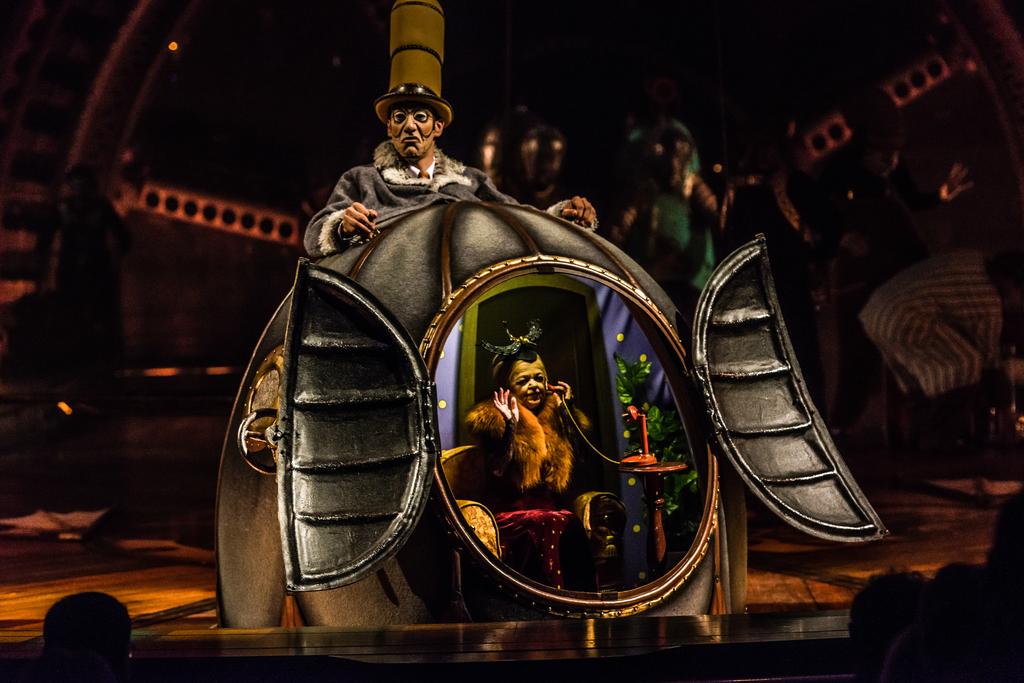
Look at this photo above. It’s clearly insane. My notes are a little screwy, but I believe that it was next that Microcosmos exposed Mini Lili‘s fully furnished home within him. Along with the previous illusion, no other image burned itself into my brain more than this one, after the show had ended. I also believe that a strobe light effect was used next to simulate a film projection, as a man entered on a propeller plane. Again, these little touches were what really made the difference in this show. Many of these acts were very reliant on human strength, balance, and agility. It might be a confusing way to put it, but they were, for the most part, very “human.” While being impressive for what physical abilities they showcased, Kurios is juggling a world of imagination with a world of physicality, so it was these little illusions and tricks that became necessary to transport these acts into another realm… something more “magical.”
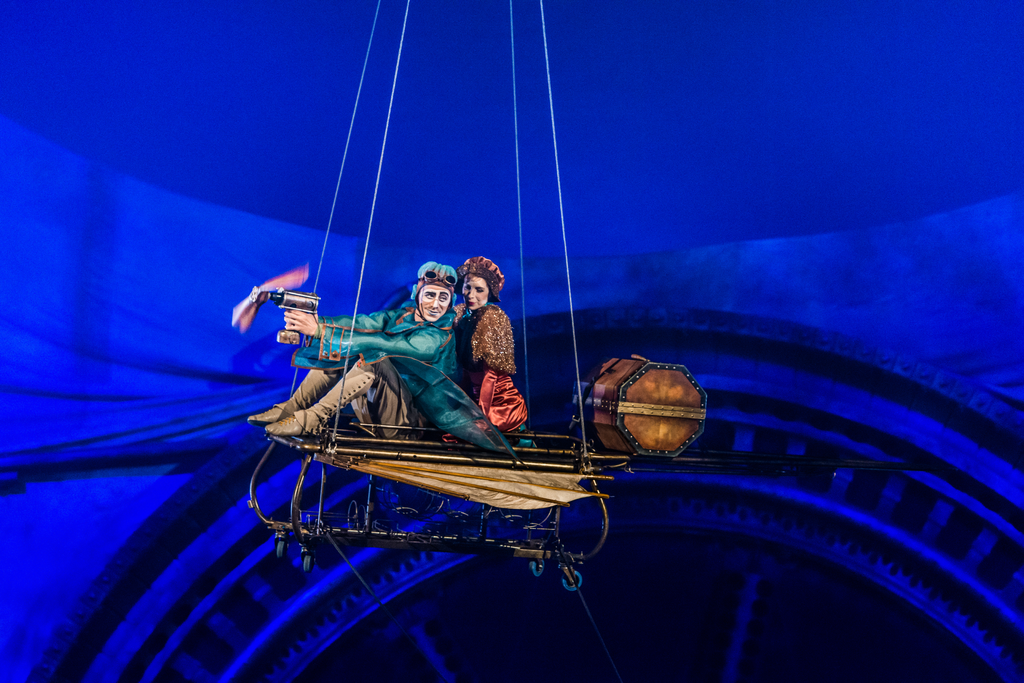
The pilot manning the propeller plane landed and, after his female passenger got off of the craft, he performed a balance board routine commonly referred to as Rola Bola. The basics of the act involved a board being placed over a cylinder that operates as an axis, while the feet of the performer rest on each end of the board to stabilize it. Demonstrating versatility, the pilot also balanced his acrylic board on top of an orb the size of a bowling ball, at one point. Other combinations involved him alternating boards on cylinders that were alternating between facing forward or sideways themselves, separated by thicker/wider acrylic cylinders placed vertically between them, raising higher and higher like a Scooby-Doo club sandwich. He even did such things as slide rings in and out of his legs and was elevated on a platform above the room while maintaining his balance. It’s a feat in itself to maintain such tension in an act of this nature, considering that the performers do multiple shows a week and this one wasn’t even the first one of the day. Still, every time the acts are performed, it really feels as if THIS is the time that they’re going down, as if we are watching Evel Knievel trying to jump the Snake River Canyon, as if this feat hasn’t already pulled of repeatedly.
The first half ended with The Seeker assembling some newfangled contraption and exiting into the sky. After the intermission, the show returned with an aquatic scene involving a giant net/trampoline and a crew of bearded men in yellow hats and jackets that resembled the Gorton’s Fisherman. They disrobed to expose themselves as fish-like creatures and performed a tumbling routine spring-boarding each other into the air. Also involved in this act was Mr Microcosmos — minus the industrial torso and stripped down to a full-bodied Victorian bathing suit — who hung upside down from a trapeze bar, occasionally catching and interacting with the flipping acrobats.
This trampoline segment was followed by the aforementioned clown act featuring the audience member and a fairly straightforward aerial strap routine with a performer soaring, swinging, and twisting from the rafters, before reaching what was, probably, the most underappreciated act of the night. Described in the press release as “1A and AP World Champion and former Duncan World Tour member,” Tomonari “BLACK” Ishiguro put on a remarkable display with his yo-yos, including a logic-defying backbend. The only problem with his routine is that, although they seemed to be a very specific and custom style ofy-yo that he was using, they were still yo-yos and I feel like it might be difficult for some people to separate the elite performance that we were watching from the Yo-yo presentations that were showcased in the school assemblies of our youth. Consciously making the effort to shake that idea from my mind, I become very aware of Ishiguro‘s unparalelled ability at his craft, and was able to acknowledge that he was, in fact, delivering exactly what I’d hoped for: a new angle that I’d never quite seen before. Still, his act seemed somewhat detached from a show that appeared to be trying to present a look into mystical foreign landscapes, and Tomonari being dressed in a dapper, yet fairly conventional, outfit didn’t help with the cause, or make his interaction with an object that can be readily found in a toy aisle appear as marvelous as it really was.
The first half seemed to have moved by faster than I remembered, and the second half flies by much quicker. I wasn’t as enthralled with the latter half up to this point and then, what was the most left-field part of the night came up. This portion was both unique and confusing to such degree that I have difficulty describing it, so I’ll just post the following description provided by the press assets themselves:
Using two cameras, one mounted on table and one portable, projecting a live feed to the audience on a round, three-projection screen, performers present a story of a person who hip-hops, swims, and later falls in love, using their hands as puppets dressed up in miniature shoes, hats, and others.
If that sounds absurd, it was. If a hand projected on a big screen that “walks” around as if the fingers were legs, even busting out breakdancing moves, seems like it’s jumping completely outside of the theme of the show… well… it kind of is. But if it all sounds incredibly awesome to you and like something that you’d like to experience, you’d be right about that too. In fact, the description really doesn’t do it justice. Along with Mini Lili‘s home and the alternate dimensional dinner party, this was one of the most visually stimulating points of the night. It had the playfulness that they shoot for with the comedy acts mixed with an intense focus on the visuals to pull it off. Even though they were just hands involved, it was still a close-up and the movements needed to be precise. It seems trivial, but there’s something to the idea of taking something like a hand and giving personality and life to it. When that works, it doesn’t matter if the references involved are 150 out of context from the rest of the program. The focus, after all, should, and is, on creating a visual spectacle, and this segment definitely accomplished that.
The final act consisted of another tumbling routine, this time involving over a dozen acrobats — 2 of which were female “fliers.” Elaborately choreographed and flawlessly synchronized, this new mob of pseudo-fish/seaman acrobats flipped and twisted through the air, were sprung off of forearms, being caught on each others shoulders, lifted into pyramids, and reorganizing themselves into different layouts for different sequences, all the while doing little dance moves and “jazz hands” in time as they shifted to keep things moving. The banquine is another classic acrobatic act comprised of “bases” operating as the platform/foundation for the “fliers” to engage in, hopefully, awe-inspiring aerial maneuvers — anyone who’s watched competitive cheerleading understands the basic fundamentals — but the Cirque just happens to do it, like so many other things, better than just about anyone. The show ended with The Seeker being lowered down and all of the performers from throughout the night coming out in groups to bow in a loose, choreographed au revoir. I looked over at Kim. She was crying again.
In the end, Kurios proved to be another remarkable showcase by the Cirque Du Soliel. But… from my experience, all of their shows have been great — at least the ones that I have witnessed. Their current residency at Marymoor Park in Redmond, Wa (the place where we saw them) ends this weekend (March 21-22nd, 2015), before opening back up in Calgary, Alberta in April and Denver in June — additional show dates in Chicago, Costa Mesa, and Los Angeles to be announced (dates and tickets HERE). I guess that the main question is if it’s worth paying the money, making the effort, and spending the time to go see Kurios or not, and my belief is that it definitely is, especially if you’ve never caught a Cirque Du Soleil performance before. The truth of the matter is that there is nothing else quite like a Cirque show, meaning that the only thing that it can be reasonably compared to are the other shows put on by the company. Plus, this is one of their traveling shows, this isn’t Las Vegas — they have a number of shows out there and were even instrumental in redefining the type of acts that are presented on the strip, in general — so when it comes to your town, go; it’s an event, there’s nothing else comparable, or to weigh it against, and it will definitely stay with you well after you’ve left the big top. There are a great number of positives to be said about what is the latest touring show for the Canadian entertainment company, and plenty of praise to be thrown toward Kurios, as I’ve already used thousands of words in this review to do. But, with all of that being said, the unfortunate truth of the matter is that, if I had to compare this to the previous performance that we witnessed of Amaluna — currently preparing to tour Spain and Belgium — I believe that Amaluna would probably have to take it, hands down. And although I stand behind that evaluation, I also believe that Kurios has the potential to be even greater than it already is, perhaps even one of the best shows that the Cirque has produced, if they are willing to continue development and implement a few adjustments.
Perhaps, the biggest strike against Kurios is its lack of storyline; the majority of the acts seemed far too arbitrary and disconnected to establish any real narrative, or warrant any real investment in the characters on any emotional level. Loosely 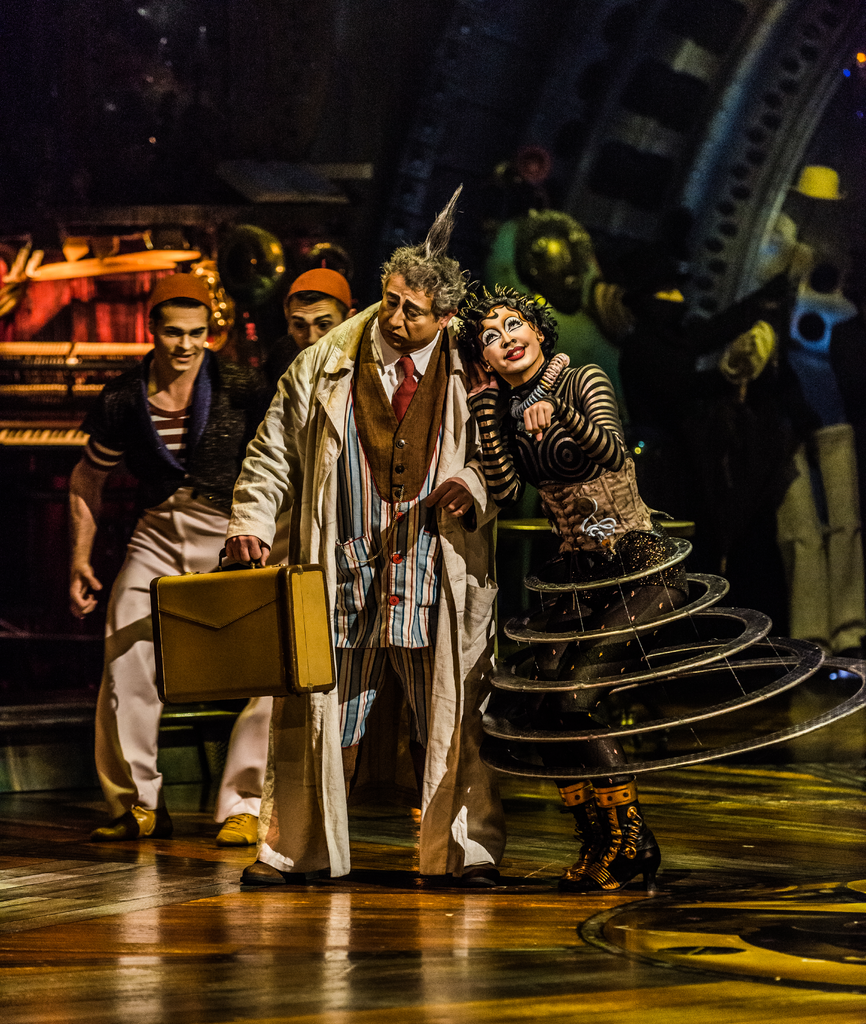 based around Shakespeare‘s The Tempest, Amaluna maintained a fairly consistent world throughout the show, along with a fairly straightforward storyline. I didn’t respect the love story in that show enough, believing that the only really “important” aspect was the dexterity, agility, physical strength, and all around superhuman feats being performed, and that the routines could have stood alone, even without any of the surrounding elements, such as costuming, storyline, character development, and music. The truth of the matter is that these elements all work together to create the overall experience. Just like in the acts, there are delicate balances, and there were moments when that balance in Kurios seemed off. There are, apparently, backstories regarding Klara having the ability to emit “alpha waves” by adjusting her hoop skirt and explanations about how The Seeker was attempting to travel through dimensions, only to have it backfire, but my belief is that I shouldn’t be required to either scour the internet, or pay for a $30 program on the premises just to obtain a very basic grasp of what was supposed to be occurring for a performance like this. And even now, after reading such material, the show still doesn’t feel that well connected and there are a number of things that still don’t add up for me. [I still have absolutely no idea about the connection to sea life, or why so much of it made an appearance.]
based around Shakespeare‘s The Tempest, Amaluna maintained a fairly consistent world throughout the show, along with a fairly straightforward storyline. I didn’t respect the love story in that show enough, believing that the only really “important” aspect was the dexterity, agility, physical strength, and all around superhuman feats being performed, and that the routines could have stood alone, even without any of the surrounding elements, such as costuming, storyline, character development, and music. The truth of the matter is that these elements all work together to create the overall experience. Just like in the acts, there are delicate balances, and there were moments when that balance in Kurios seemed off. There are, apparently, backstories regarding Klara having the ability to emit “alpha waves” by adjusting her hoop skirt and explanations about how The Seeker was attempting to travel through dimensions, only to have it backfire, but my belief is that I shouldn’t be required to either scour the internet, or pay for a $30 program on the premises just to obtain a very basic grasp of what was supposed to be occurring for a performance like this. And even now, after reading such material, the show still doesn’t feel that well connected and there are a number of things that still don’t add up for me. [I still have absolutely no idea about the connection to sea life, or why so much of it made an appearance.]
The full name of Kurios, references a “cabinet of curiosities” and with the Russian cradle duo portraying a pair of figurines pulled from a case and animated through electrification, the opening act fell in line with that theme nicely; however, that focus seemed to be quickly diverted. One particular descriptor about the show that I came across reads as follows:
“A fitting tribute to the power of the human imagination, the costumes of KURIOS by Cirque du Soleil are the result of a visual exploration of the beginnings of science, of the discoveries and inventions that led to the industrial revolution of the 19th Century.“
The costumes, of course, were brilliantly crafted, but to have a pilot in the mix doesn’t exactly reflect “19th century” in my mind. Orville and Wilbur Wright didn’t achieve their goal of having “…the first powered, heavier-than-air machine to achieve controlled, sustained flight with a pilot aboard” until the end of 1903, when their Wright Flyer left the ground in Kittyhawk, NC, basically, establishing the brothers as the inventors of the very first functional airplane. After that, it wasn’t until 1927 that Charles Lindbergh historically, made the first solo, non-stop trans-Atlantic airplane flight, ever. With the amalgamation of aesthetics and references throughout Kurios, both musically and visually, a good amount of them penetrated deep into the 20th century. Was The Seeker time traveling, as well? It didn’t seem so, but maybe. [Seriously, what was with all of the fish.] In regards to the very early birth of primitive film — a film projector was referenced in the intro for the rola bola act — we are looking toward the very tail end of the 19th century, which is also when Welles penned his novel, The Time Machine. The turn of the century would be a good mid-point to assume what we’re hovering around in Kurios, but if so, we are well removed from the beginnings of technology built on steam half a century prior. And the inclusion of such 1920s – 30s elements and later, including swing music, throws a completely different curveball into the mix. But the only reason to inquire about the time period, is to establish some sort of continuity, which I haven’t found elsewhere — if it was all about focusing on the 19th century, then maybe I could find some cohesion in this show. Like I stated previously, when the routines are working, as with the amazing eel-like contortionists, none of this hairsplitting really matters, at all. Unfortunately, I didn’t find most of them to be quite as successful.
The cradle duo was a great opening act with an even better introduction, and it was placed at the right spot on the schedule, because it doesn’t have as much visual flash as most other routines. It’s not dissimilar to watching a skateboarding competition, wherein some of the less interesting tricks justifiably yield higher scores, because of their higher level of difficulty. As a viewer, however, knowing something is difficult and demands great skill isn’t enough, you also have to keep my attention — and let’s not forget that points are also distributed for combinations, style, and originality. With Kurios, the acts seemed to lack the variety that Amaluna delivered. I understand that swinging upside down on the bike took skill and would understand it even more if it was ever explained why the performer was delivering the letter (or what it was written in reference to) but barring that, it’s inclusion was lackluster and confusing at best. I also have no idea why a dinner party slipped into the equation, other than to set up another balancing act. The banquine closed out the night, but felt like little more than a combination of the cradle duo and the other large ensemble act of acrobats in the trampoline net. The chair stacking routine, followed the previous balancing act of the contortionists, and was then followed by the balancing act of the rola bola. Of course, it’s true that the foundation to most of the acts is going to deal with balance, strength, agility, endurance, etc and/or a combination therein — there’s only so much to draw from — but even the last show that we witnessed didn’t feel as redundant. Amaluna involved bird-like women on unicycles, chin balancing and a giant water bowl act, a terrific Chinese pole routine, a group of female tumblers resting on the feet of men on their backs who flipped them as they swung “water meteors” overhead bolo-style, and a lizard man showcasing really impressive juggling abilities — I would have loved to have seen more of the juggler in this show as well,. There were moments of dance and a focus placed on the silhouettes of performers interacting with each other in the same way that made the eel act so successful this time around. When they dealt with similar skills, they were differentiated by the use of something like uneven bars versus a teeterboard act, to separate them and make them feel completely different. There was a segment in Amaluna that was similar to the bike routine in Kurios, but with a goddess being lowered down on a massive ring, and there was also an aerial strap routine (in fact, two), but they still felt less redundant than they did this time around.
https://www.youtube.com/watch?v=HmnJBc0M1lY
And this is the most unfortunate variable in my review, the fact that the aerial strap routine in Kurios seems to have had one key element missing: the other performer. The weak link in the lineup was that man soaring majestically from the ceiling — in a way just another performer swinging from up high in this show, by that point — whose only fault was that he had perfected a craft that we had seen performed in a similar fashion too many times before. But in viewing the trailer (above) and looking at the press assets, it’s clear that this was a “siamese twins” routine, involving a second performer, and based around precision, timing, synchronicity, and symmetry; in other words, the elements that have the ability to turn an impressive visual display into a truly transcendent one. Where was the other twin? Most likely, he was sick or injured. More than anything, the fact that the show continued through such a rigorous schedule is testament to the unmatched professionalism and endurance of the Cirque and its performers. It’s unfortunate that my review is based on a performance that had a divot in it, because, although I don’t know to what magnitude, I do know that the weakening of that one act affected my overall view of the entire show, due to that delicate balance and interconnectedness which is so vital to both maintaining belief in that world and sustaining that momentum.
It may not be entirely possible for me to give a 100% accurate review of Kurios, now knowing that I may have witnessed an altered/slightly lesser version of the show — also featured in the trailer is a terrific illusion where Microcosmos appears to have multiple legs, which I don’t remember — but I do still feel that the overall show could be easily improved. Kurios was only first introduced last year and, based on both the trailer and press images that I’ve seen this week, there appears to have already been a few character and costume adjustments made — can you believe that the banquine may not have been entirely comprised of fish-people in an earlier version? When I heard about the Cirque Du Soleil‘s resident Criss Angel: Believe show at the Luxor in Vegas, and all of the obstacles that it had endured, it seemed like an obviously misguided effort to me, simply based on a desire to “unnecessarily” highlight illusions when the bread and butter of these shows is clearly the physical abilities of the performers. After seeing Kurios, however, I realize that these two arts needn’t be mutually exclusive to one another. If the show aims to blur the line between reality and fantasy, as it claims, then those illusions — the strobe/projector, the alternate dinner party dimension, etc. — are the key and the adhesive that holds this show together. In fact, it is my personal opinion that the show should be restructured to find areas where similar techniques could be utilized more. I also believe that the sequencing should be reevaluated to avoid having similar acts fall back-to-back and minimize redundancy; perhaps, even replacing one or two of them to provide more variety. There is so much that could be done with the steampunk aesthetic and I was really excited for Kurios, knowing that they would be embracing it, but I don’t feel that potential was maximized. Of course, I’d like to see more of the robots and technology, but I’d really just like to see more focus in general. If it’s a story about inter-dimensional travel, then focus on honing that angle more and delivering that storyline. If it’s a tale about a cabinet of curiosities, then why not focus on delivering that angle more successfully? Too many ideas may have spread Kurios a bit thin, weakening each element, by diverting the focus in too many directions.
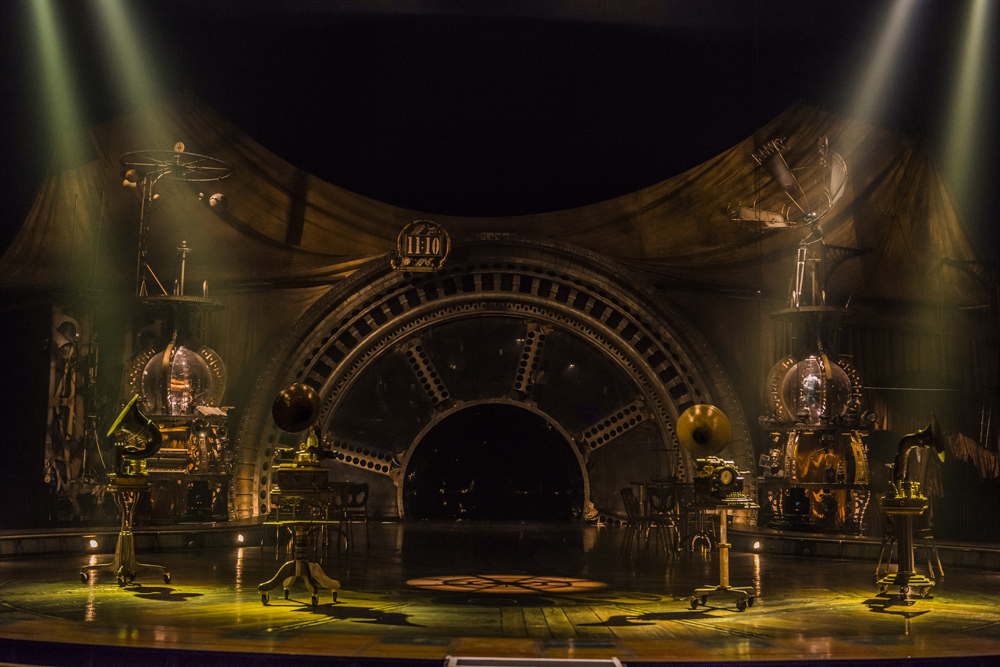
The reason that Kim was brought to tears during the intro and outro portions is because of how condensed and potent those sequences were, but there were very few moments throughout the show that made us forget where we were at, for just as long, and suspended us in that magical world. During Amaluna, she actually turned to me and confessed that she wanted to live there. Where? Not in a tent constructed in the parking area of Marymoor Park, of course, but in a world that she was convinced, at least on an emotional level, actually existed somewhere outside of her everyday world and everyday life. That’s not to say that Kurios didn’t have its moments, that it didn’t come close to generating that sensation, or even that it didn’t manage to penetrate that world, on occasion, but it wasn’t quite as successful at sustaining it. To make use of the skateboarding competition analogy once again, a run can contain some really impressive tricks, but it’s hard to recover and maintain that momentum after a fall, and even more difficult, after a few of them. But, perhaps, a much more fitting comparison would be to equate it to missing a clean catch on the trapeze, by either dropping your partner or stumbling and coming close to it. It’s similar to the wind cutting out from underneath a kite; it might not hit the ground, but a quick nose-dive, before being corrected, or even occasional dips and slumps, are still enough to break that focus and take away from the entire experience. It’s too bad that one of the biggest stumbles came by losing an aerial strap performer, at a point where the momentum was essential, but confusing gaps/lack in storyline, wounded the transitions, and, in turn, created minor slumps throughout, detaching us from that wonderful fantasy that the rest of the show worked so hard to generate. I applaud the Cirque for their ambition with Kurios, the set design was untouchable and the incorporation of illusions into this show was a brilliant addition, but the desire to split off into too many directions, left the show feeling a bit drawn and quartered at times. Admittedly, my standards have become incredibly high, but that’s only because of the how high the bar has been raised by the Cirque Du Soleil over the last 25 years since their inception. Although I greatly enjoyed the show, I feel as if I’d be doing both the readers and the entertainment company a disservice, if I didn’t use this review to express my true feelings, unfiltered. The truth of the matter is that, ff they continue to develop this act and make adjustments, accordingly, to blend these disparate aspects together a bit more, as I believe they will, this could easily be the most visually stunning display that they have ever assembled.
